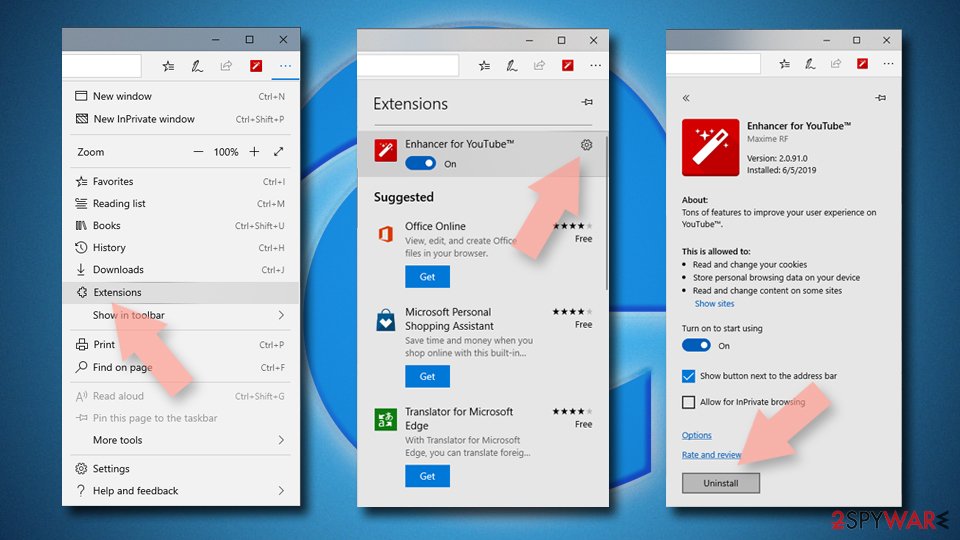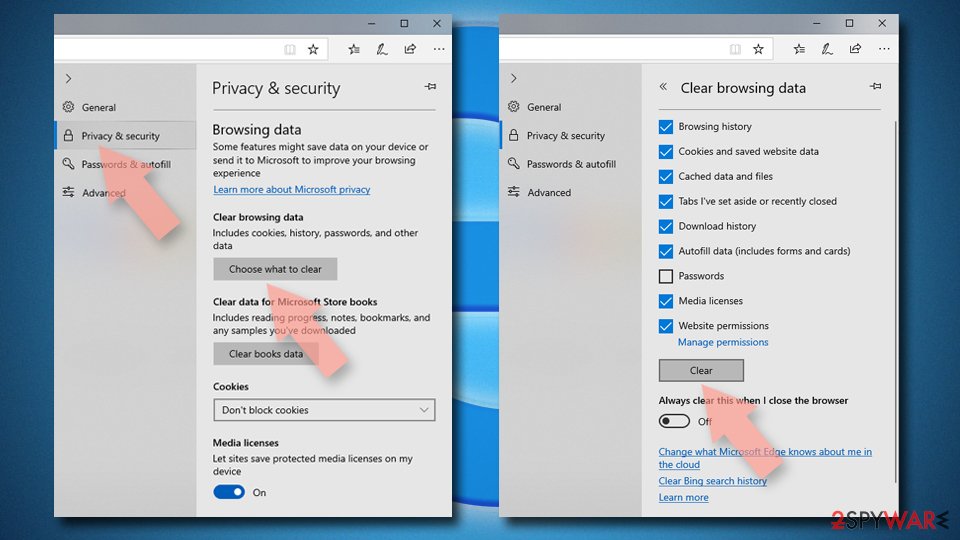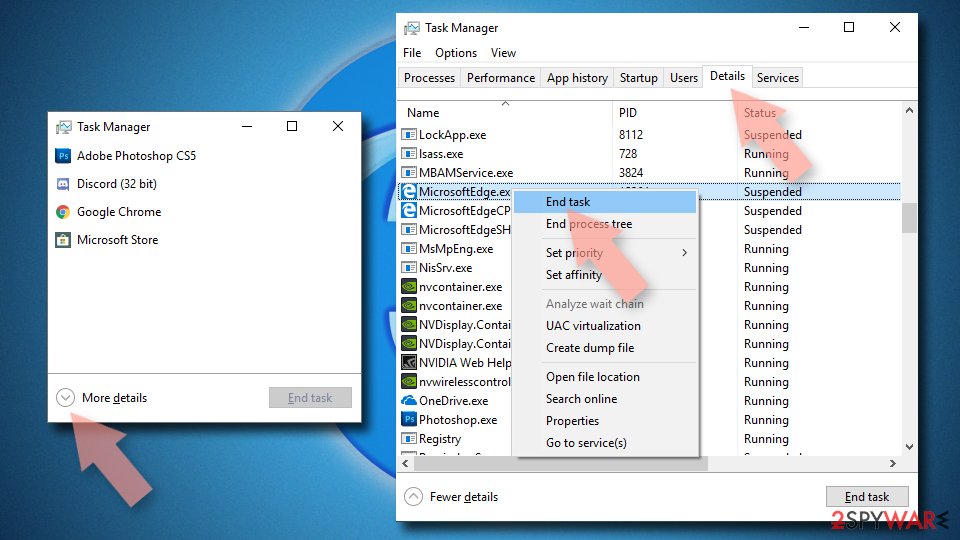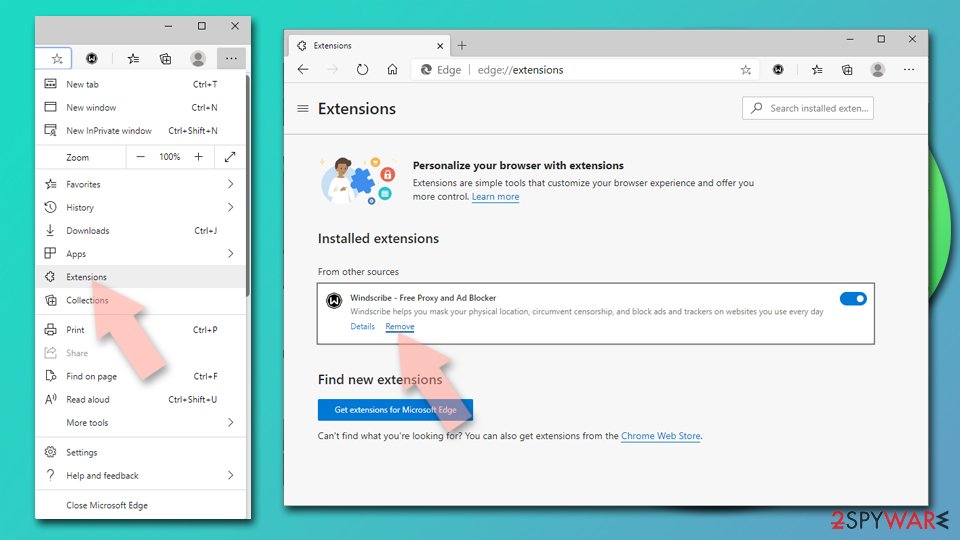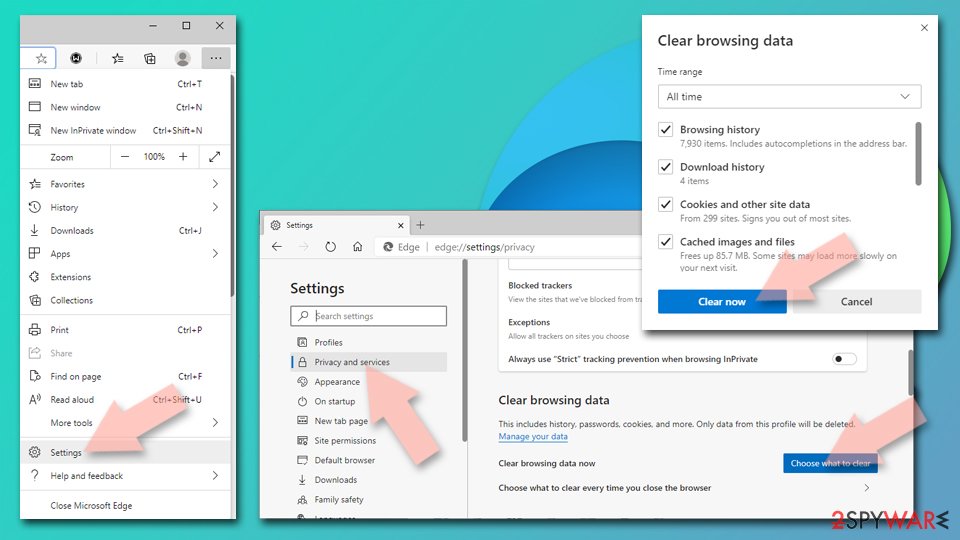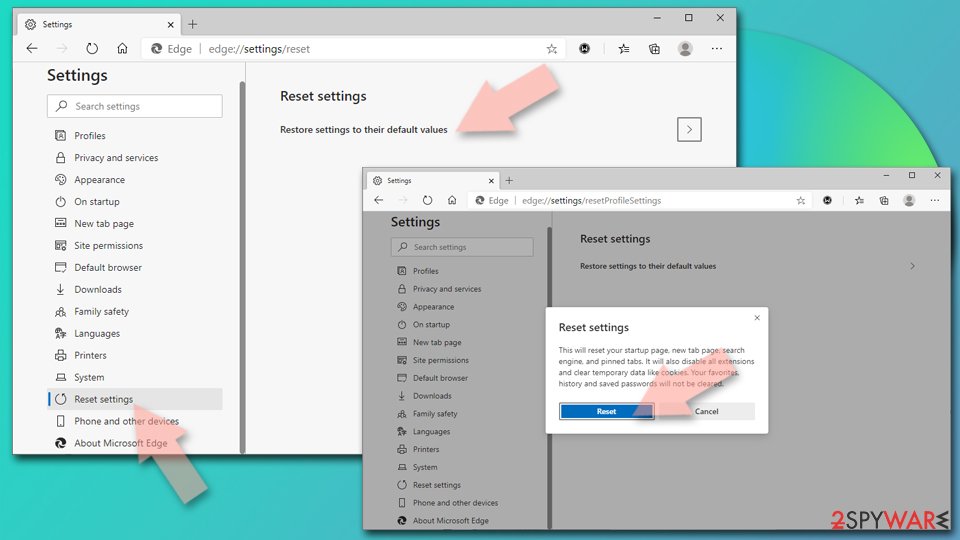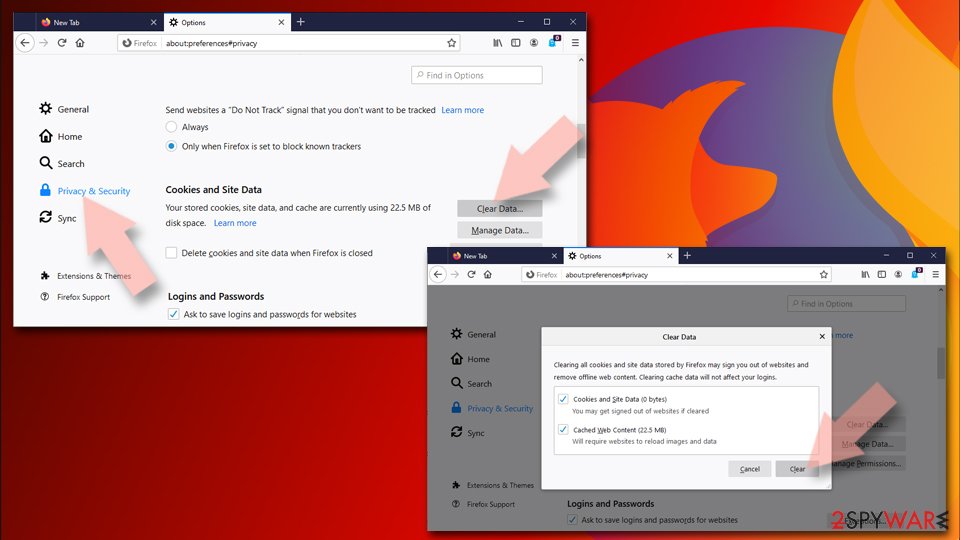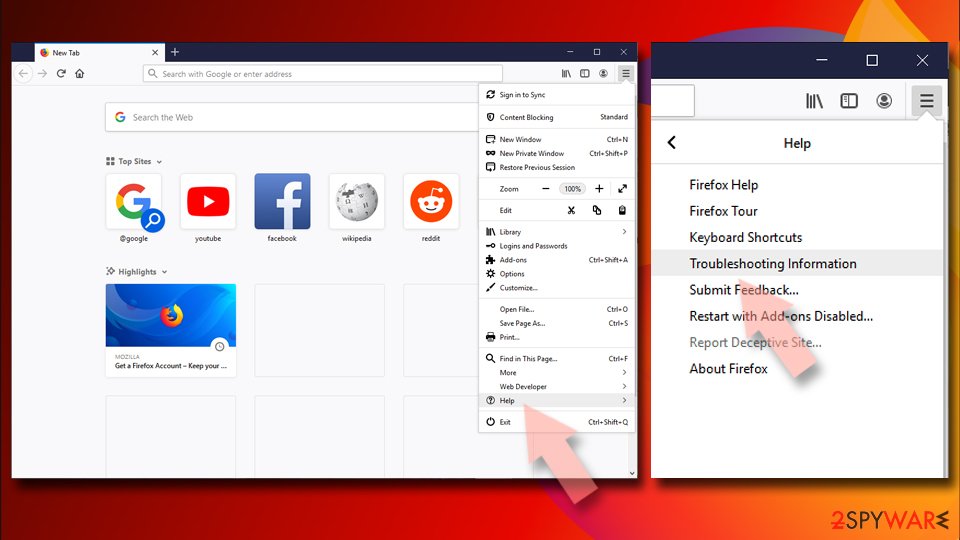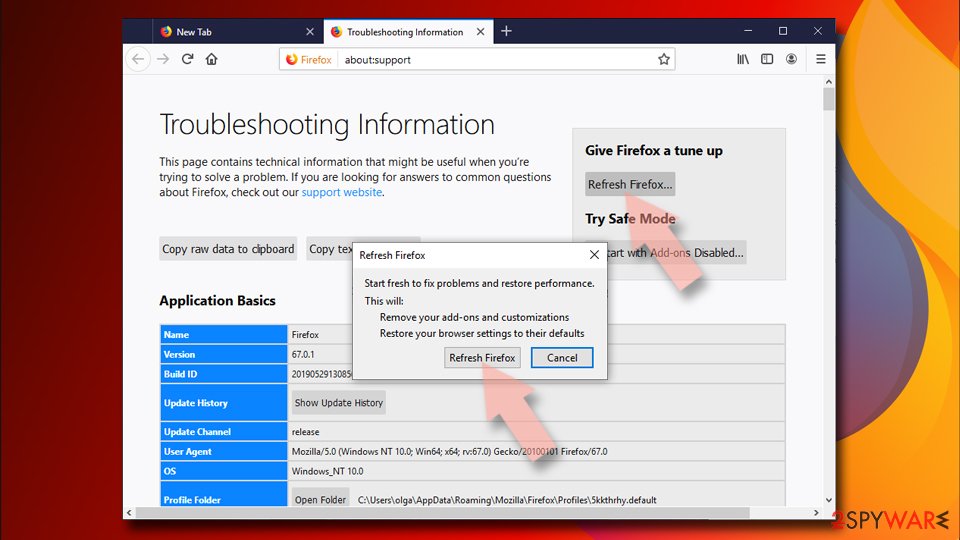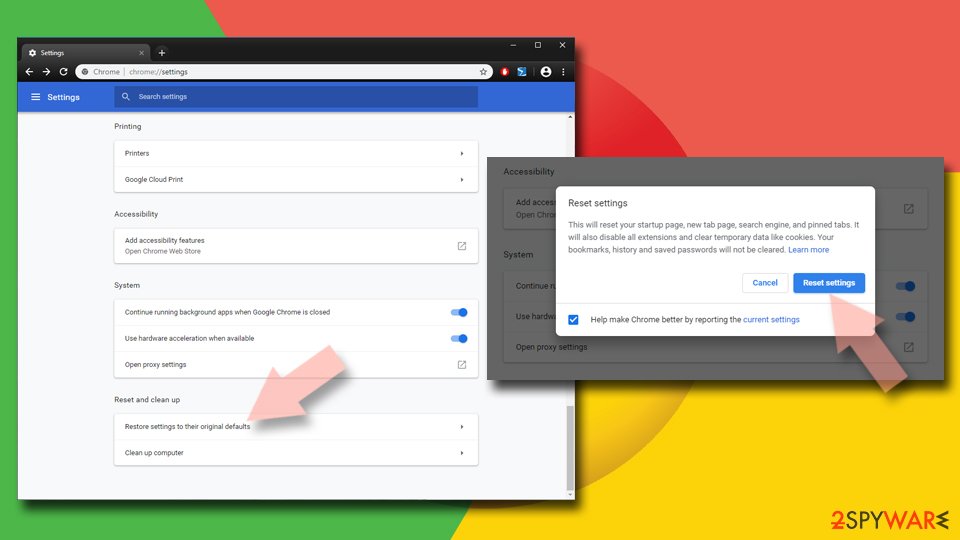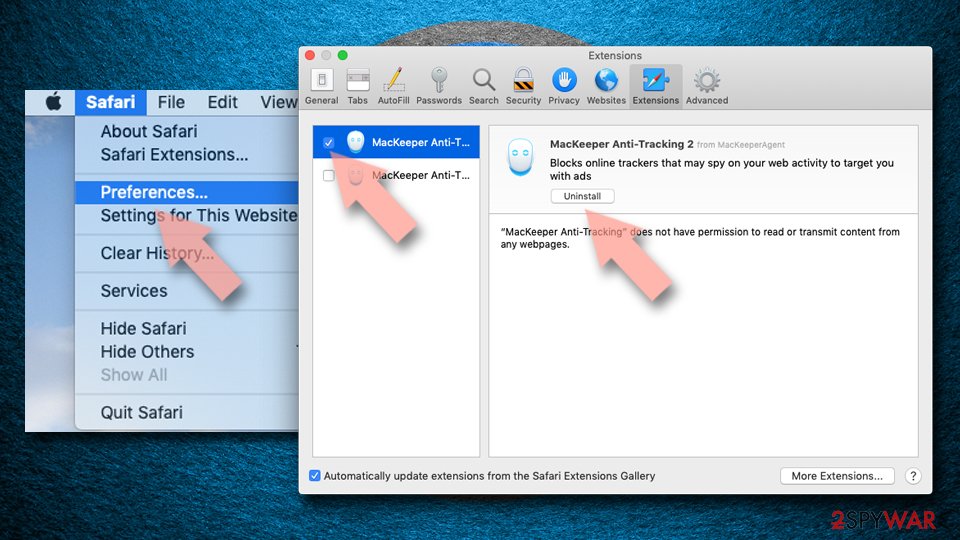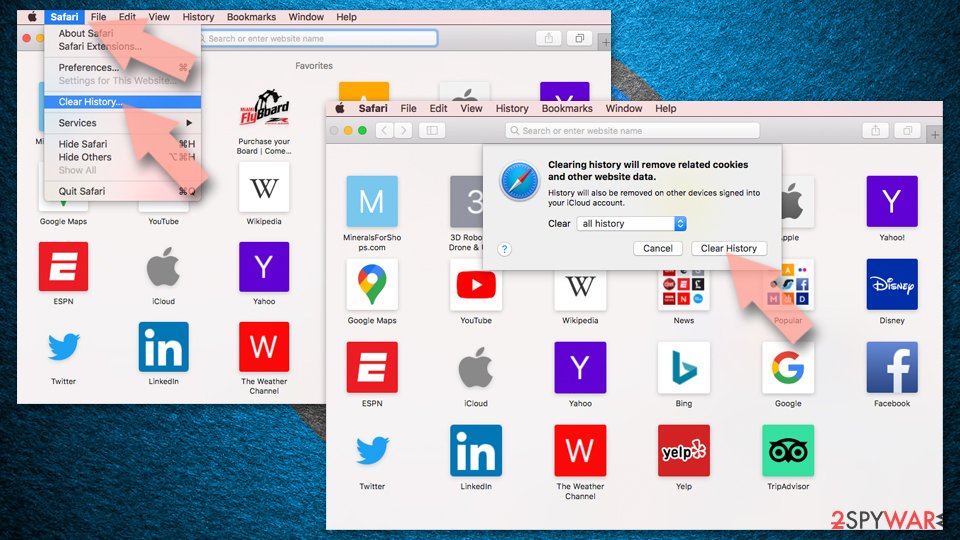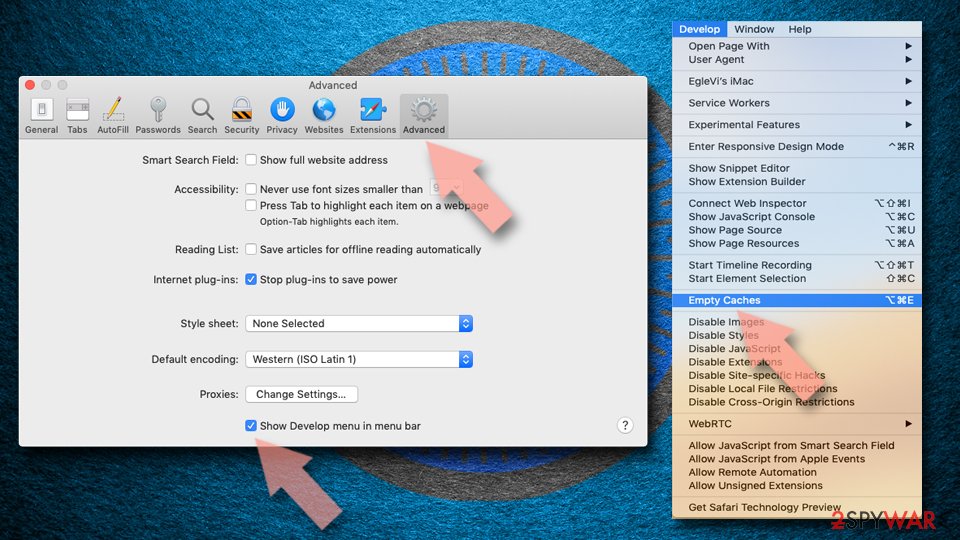“Windows Defender Alert: Zeus Virus” Tech Support Scam (Removal Instructions) - Jun 2019 update
“Windows Defender Alert: Zeus Virus” Tech Support Scam Removal Guide
What is “Windows Defender Alert: Zeus Virus” Tech Support Scam?
Zeus virus detected is a fake error message that tries to make users call a bogus tech support service
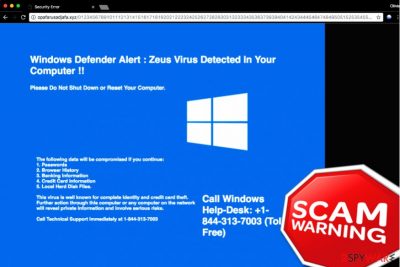
Windows Defender Alert: Zeus Virus is Zeus virus scam claiming that Zeus virus is detected on the machine. In reality, the error message that resembles legitimate Windows alerts is entirely fake – it appears inside the Google Chrome, Mozilla Firefox, Internet Explorer or another browser, instead of a full, locked screen as it is typical to the real error reports from Microsoft.
However, one might ask why Windows Defender Alert: Zeus Virus notifications are appearing seemingly out of nowhere? The answer is adware – these potentially unwanted programs usually enter machines without notifying their owners and modify web browser settings in order to insert banners, in-text links, pop-ups, and other commercial content during web browsing sessions.
However, while some ads might be not more than an inconvenience, the malicious redirects are the ones that link users to Zeus Virus scam sites. In reality, their computers are not infected with the notorious Zeus virus – banking malware[1] that began to spread around the internet in 2007 and affected more than 74,000 FTP accounts of NASA, ABC, Amazon, and other high-profile corporations, as well as infected thousands of regular users worldwide.[2]
Fortunately, the malware was terminated in 2011, but malicious scammers keep claiming that the computer is damaged and Zeus virus detected on the system with the help of adware campaigns.
| Name | Windows Defender Alert: Zeus Virus |
|---|---|
| Type | Closely related to adware |
| Can be found on | Rogue pages, in software packages |
| Relations made with | Zeus virus. Gladly, this cyber threat is no longer active |
| Prevention | Use original installers, avoid rogue sites |
| Detection | FortectIntego can detect the PUP |
| Removal | Use automatical tools for the removal |
Typically, when a potentially unwanted program (PUP) enters a computer, it causes unwanted ads and redirects to sponsored websites. However, it can also initiate redirects to phishing websites that show Zeus virus detected messages[3] and fake security warnings used for stealing users' money.[4] Nevertheless, you might infect your computer system with dangerous malware if you do not get rid of the rogue application on time.
One of such warnings is Windows Defender Alert: Zeus Virus scam, which can appear even when you visit a legitimate site. To scare unaware PC users, it uses a blue background, also identified as a Blue Screen of Death (BSoD), and similar elements. Keep in mind that Windows Defender would never use BSoD to warn its user about malware. Also, it doesn't open alerts via a web browser in such an intrusive way.
Typically, the Zeus virus scam claims:
*******************************************************
RDN/YahLover.worm!055BCCAC9FEC infection
*******************************************************
Windows Defender Alert: Zeus Virus Detected In Your Computer !!
Please Do Not Shut Down or Reset Your Computer.The following data will be compromised if you continue:
1. Passwords
2. Browser History
3. Credit Card Information
4. Local Hard Disk Files.This virus is well known for complete identity and credit card theft. Further action through this computer or any computer on the network will reveal private information and involve serious risks.
Call Microsoft Technical Department (Toll Free)
The number which is provided in this scam is (888) 252-1520. However, it has been changed for several times, so you can be asked to call another number to reach “Microsoft technicians”. Keep in mind that these people are scammers who are ready to do anything to swindle your money.
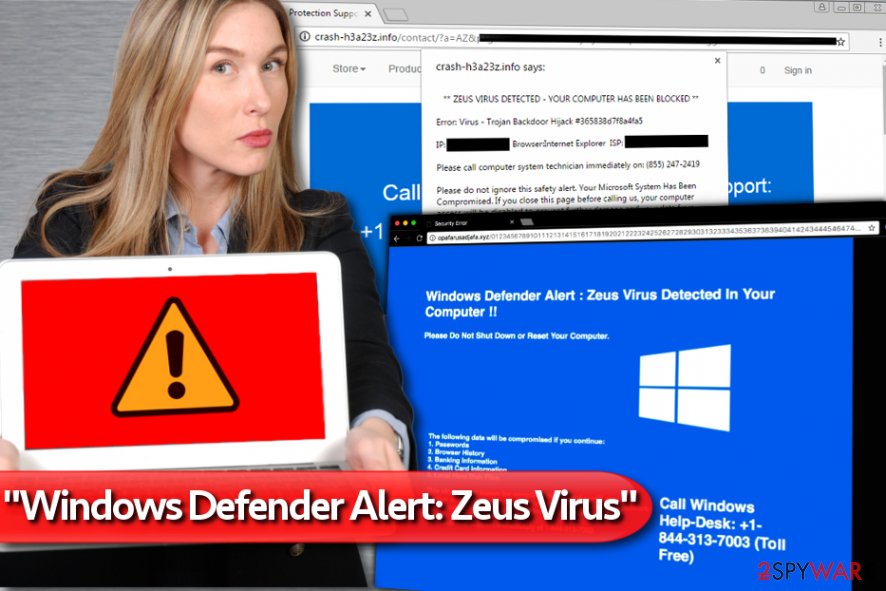
For that, they create such alerts as Zeus virus detected scam which mimic Microsoft. Their aim is to initiate the sense of urgency and trick the victim into calling the scammers who can either sign up him/her for useless services or infect the target computer with malware. In this case, you can lose your personal information with only one call.
If you noticed such messages on your screen, you should remove Zeus virus scam without wasting your time. When dealing with Tech support scams, we recommend using FortectIntego.
Scammers that wait for victims to call them are ready to tell all kinds of lies. People who are hiding behind Windows Defender Zeus Virus alert are on prey for easy targets – if the victim gets convinced to call the scammers, it is likely that he/she will follow their commands as well. This might lead to unwanted consequences, for example, unexpected money losses.
First of all, the developers who spread Windows Defender Zeus Virus ask what picture is displayed on the user's computer screen. This way, they understand what kind of tech support scam program the victim was infected with. Then, they tell the victim to go to particular computer folders, press keyboard keys and do other things that are useless. These tasks are used just to confuse the victim.
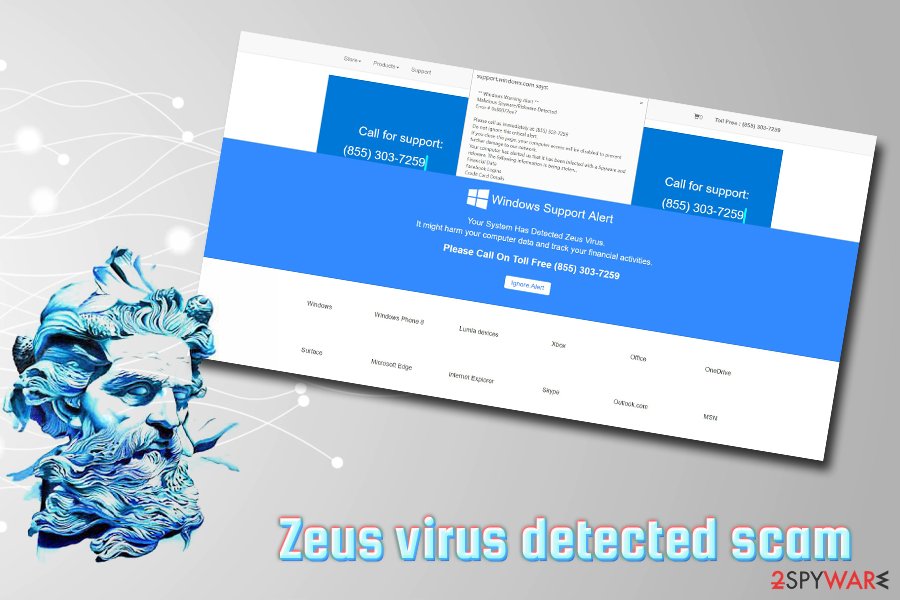
Finally, they announce that the problem is very serious and urge the victim to buy an overpriced security software pack or, even worse, they suggest “helping” the user remotely. If the victim provides remote access to the computer system, scammers can easily infect it with the desired virus, e. g., ransomware, a trojan horse[5] or another dangerous program. To avoid contact with scammers and keep your computer safe, users should perform the Zeus virus scam removal.
Malware related to Zeus virus
Zeus trojan
Zeus Trojan virus is one of the most prevalent data-stealing malware samples that was disabled in 2016. It is also known as Zbot Trojan and Gameover Zeus. Once installed, it was used to collect sensitive information by recording user's keystrokes. It was able to operate behind the user's back for weeks, months or even years.
All information collected by Zeus Trojan was transferred to its Command & Control center. This center has also been used to receive commands from virus developers.
Zeus Panda virus
Zeus Panda virus has also been categorized as a banking Trojan as its main targets are financial information and logins. While this virus operates the same way as previously described Zeus Trojan, the phrase “Zeus Panda virus” was introduced because this virus was created on the same code as an infamous Trojan horse. At the moment, Zeus Panda tries to avoid Russian-speaking countries, so it has been speculated that the virus hails from these countries.
Nevertheless, Zeus Panda virus is also incorporated in Zeus virus scam, so watch out for bogus messages within web browsers that claim the infection.

Terdot virus
Terdot virus is the newest malware related to Zeus virus. Just like the previous ones, this threat seeks to take over people's personal information. However, its main targets are social media credentials. It has been reported that the virus seeks to steal users' Yahoo, Gmail, and Microsoft live.com login information.
Deceptive programs are distributed using different methods
NoVirus experts[6] report that tech support scams distribute malware using software bundling, malicious spam, and other techniques. Luckily, victims can prevent installing such malicious programs quite easily. Usually, all that the user needs to do is to avoid opening shady email attachments and installing freshly downloaded software the right way.
Wondering what is the right way to install computer programs? Let us clear this out for you. Sadly, many people believe that it is enough to hit the “Next” button several times and then click “Finish” to complete the process. Sadly, such way of installation is likely to grant several potentially unwanted programs a permission to enter the computer system unnoticed
For this reason, we always recommend reading Privacy Policy and Terms of Use documents and adjusting the installation settings the right way. To do that, select Custom or Advanced settings instead of Default or Standard ones. All that is left to do is to deselect unwanted apps and extensions suggested to you.
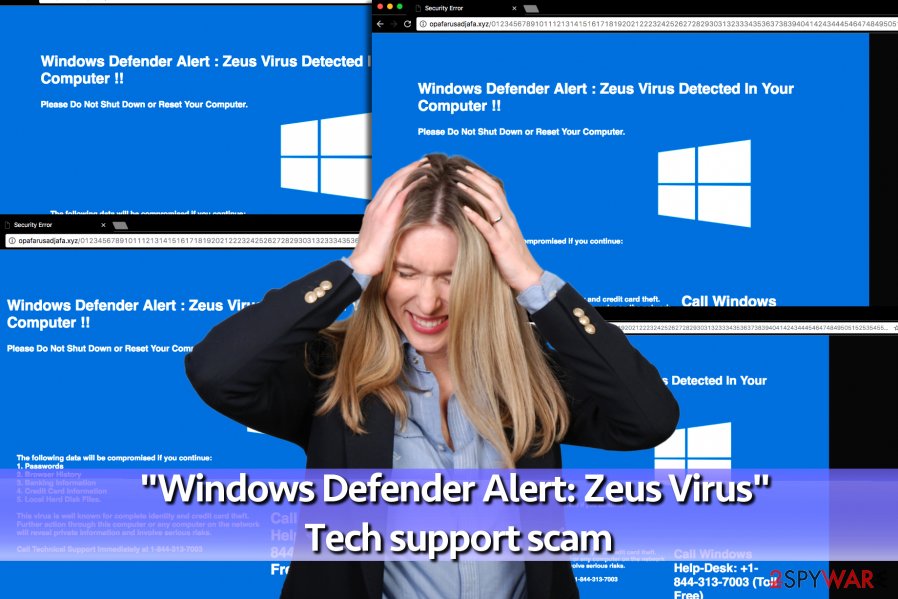
Remove Windows Defender Zeus virus alert
If the described pop-ups emerge on your screen on a daily basis, do not delay the Zeus virus detected removal. To eliminate the virus, choose a decent anti-malware program that will do all the work for you. Before that, you should quit your web browser and eliminate the scam from your desktop.
If you want to fix this error manually, you can remove Zeus virus scam with the help of steps given below. However, you will have to find all programs that are showing this annoying pop-up on your computer. Make sure you are careful enough to follow every step in the right order to remove “Windows Defender Alert: Zeus Virus” fake alerts completely.
You may remove virus damage with a help of FortectIntego. SpyHunter 5Combo Cleaner and Malwarebytes are recommended to detect potentially unwanted programs and viruses with all their files and registry entries that are related to them.
Getting rid of “Windows Defender Alert: Zeus Virus” Tech Support Scam. Follow these steps
Uninstall from Windows
To fix Windows OS, you need to uninstall all suspicious programs that could be related to this scam. If you can't remember installing a program on your computer, you must remove it.
Instructions for Windows 10/8 machines:
- Enter Control Panel into Windows search box and hit Enter or click on the search result.
- Under Programs, select Uninstall a program.

- From the list, find the entry of the suspicious program.
- Right-click on the application and select Uninstall.
- If User Account Control shows up, click Yes.
- Wait till uninstallation process is complete and click OK.

If you are Windows 7/XP user, proceed with the following instructions:
- Click on Windows Start > Control Panel located on the right pane (if you are Windows XP user, click on Add/Remove Programs).
- In Control Panel, select Programs > Uninstall a program.

- Pick the unwanted application by clicking on it once.
- At the top, click Uninstall/Change.
- In the confirmation prompt, pick Yes.
- Click OK once the removal process is finished.
Remove from Microsoft Edge
Delete unwanted extensions from MS Edge:
- Select Menu (three horizontal dots at the top-right of the browser window) and pick Extensions.
- From the list, pick the extension and click on the Gear icon.
- Click on Uninstall at the bottom.

Clear cookies and other browser data:
- Click on the Menu (three horizontal dots at the top-right of the browser window) and select Privacy & security.
- Under Clear browsing data, pick Choose what to clear.
- Select everything (apart from passwords, although you might want to include Media licenses as well, if applicable) and click on Clear.

Restore new tab and homepage settings:
- Click the menu icon and choose Settings.
- Then find On startup section.
- Click Disable if you found any suspicious domain.
Reset MS Edge if the above steps did not work:
- Press on Ctrl + Shift + Esc to open Task Manager.
- Click on More details arrow at the bottom of the window.
- Select Details tab.
- Now scroll down and locate every entry with Microsoft Edge name in it. Right-click on each of them and select End Task to stop MS Edge from running.

If this solution failed to help you, you need to use an advanced Edge reset method. Note that you need to backup your data before proceeding.
- Find the following folder on your computer: C:\\Users\\%username%\\AppData\\Local\\Packages\\Microsoft.MicrosoftEdge_8wekyb3d8bbwe.
- Press Ctrl + A on your keyboard to select all folders.
- Right-click on them and pick Delete

- Now right-click on the Start button and pick Windows PowerShell (Admin).
- When the new window opens, copy and paste the following command, and then press Enter:
Get-AppXPackage -AllUsers -Name Microsoft.MicrosoftEdge | Foreach {Add-AppxPackage -DisableDevelopmentMode -Register “$($_.InstallLocation)\\AppXManifest.xml” -Verbose

Instructions for Chromium-based Edge
Delete extensions from MS Edge (Chromium):
- Open Edge and click select Settings > Extensions.
- Delete unwanted extensions by clicking Remove.

Clear cache and site data:
- Click on Menu and go to Settings.
- Select Privacy, search and services.
- Under Clear browsing data, pick Choose what to clear.
- Under Time range, pick All time.
- Select Clear now.

Reset Chromium-based MS Edge:
- Click on Menu and select Settings.
- On the left side, pick Reset settings.
- Select Restore settings to their default values.
- Confirm with Reset.

Remove from Mozilla Firefox (FF)
If you have spotted some rogue content in the Mozilla Firefox web browser, check out these instructions in order to eliminate them:
Remove dangerous extensions:
- Open Mozilla Firefox browser and click on the Menu (three horizontal lines at the top-right of the window).
- Select Add-ons.
- In here, select unwanted plugin and click Remove.

Reset the homepage:
- Click three horizontal lines at the top right corner to open the menu.
- Choose Options.
- Under Home options, enter your preferred site that will open every time you newly open the Mozilla Firefox.
Clear cookies and site data:
- Click Menu and pick Settings.
- Go to Privacy & Security section.
- Scroll down to locate Cookies and Site Data.
- Click on Clear Data…
- Select Cookies and Site Data, as well as Cached Web Content and press Clear.

Reset Mozilla Firefox
If clearing the browser as explained above did not help, reset Mozilla Firefox:
- Open Mozilla Firefox browser and click the Menu.
- Go to Help and then choose Troubleshooting Information.

- Under Give Firefox a tune up section, click on Refresh Firefox…
- Once the pop-up shows up, confirm the action by pressing on Refresh Firefox.

Remove from Google Chrome
To fix Chrome web browser, you need to reset it with the help of the following steps:
Delete malicious extensions from Google Chrome:
- Open Google Chrome, click on the Menu (three vertical dots at the top-right corner) and select More tools > Extensions.
- In the newly opened window, you will see all the installed extensions. Uninstall all the suspicious plugins that might be related to the unwanted program by clicking Remove.

Clear cache and web data from Chrome:
- Click on Menu and pick Settings.
- Under Privacy and security, select Clear browsing data.
- Select Browsing history, Cookies and other site data, as well as Cached images and files.
- Click Clear data.

Change your homepage:
- Click menu and choose Settings.
- Look for a suspicious site in the On startup section.
- Click on Open a specific or set of pages and click on three dots to find the Remove option.
Reset Google Chrome:
If the previous methods did not help you, reset Google Chrome to eliminate all the unwanted components:
- Click on Menu and select Settings.
- In the Settings, scroll down and click Advanced.
- Scroll down and locate Reset and clean up section.
- Now click Restore settings to their original defaults.
- Confirm with Reset settings.

Delete from Safari
Remove unwanted extensions from Safari:
- Click Safari > Preferences…
- In the new window, pick Extensions.
- Select the unwanted extension and select Uninstall.

Clear cookies and other website data from Safari:
- Click Safari > Clear History…
- From the drop-down menu under Clear, pick all history.
- Confirm with Clear History.

Reset Safari if the above-mentioned steps did not help you:
- Click Safari > Preferences…
- Go to Advanced tab.
- Tick the Show Develop menu in menu bar.
- From the menu bar, click Develop, and then select Empty Caches.

After uninstalling this potentially unwanted program (PUP) and fixing each of your web browsers, we recommend you to scan your PC system with a reputable anti-spyware. This will help you to get rid of “Windows Defender Alert: Zeus Virus” Tech Support Scam registry traces and will also identify related parasites or possible malware infections on your computer. For that you can use our top-rated malware remover: FortectIntego, SpyHunter 5Combo Cleaner or Malwarebytes.
How to prevent from getting malware
Protect your privacy – employ a VPN
There are several ways how to make your online time more private – you can access an incognito tab. However, there is no secret that even in this mode, you are tracked for advertising purposes. There is a way to add an extra layer of protection and create a completely anonymous web browsing practice with the help of Private Internet Access VPN. This software reroutes traffic through different servers, thus leaving your IP address and geolocation in disguise. Besides, it is based on a strict no-log policy, meaning that no data will be recorded, leaked, and available for both first and third parties. The combination of a secure web browser and Private Internet Access VPN will let you browse the Internet without a feeling of being spied or targeted by criminals.
No backups? No problem. Use a data recovery tool
If you wonder how data loss can occur, you should not look any further for answers – human errors, malware attacks, hardware failures, power cuts, natural disasters, or even simple negligence. In some cases, lost files are extremely important, and many straight out panic when such an unfortunate course of events happen. Due to this, you should always ensure that you prepare proper data backups on a regular basis.
If you were caught by surprise and did not have any backups to restore your files from, not everything is lost. Data Recovery Pro is one of the leading file recovery solutions you can find on the market – it is likely to restore even lost emails or data located on an external device.
- ^ Simon Batt. What Is a “Banking Trojan?”. Make Tech Easier. Computer Tutorials, Tips and Tricks.
- ^ Jim Finkle 5 MIN READ. Hackers steal U.S. government, corporate data from PCs. Reuters. International news network.
- ^ How Can I Identify a Phishing Website or Email?. Yahoo Safety - Security. Top Security Tips.
- ^ Support scam malware. Microsoft - Malware Protection Center. Tips on How To Protect Your Computer From Malware.
- ^ Trojan horse (computing). Wikipedia. The free encyclopedia.
- ^ NoVirus. NoVirus. Malware, Spyware Removal Tutorials, Cyber Security News.



